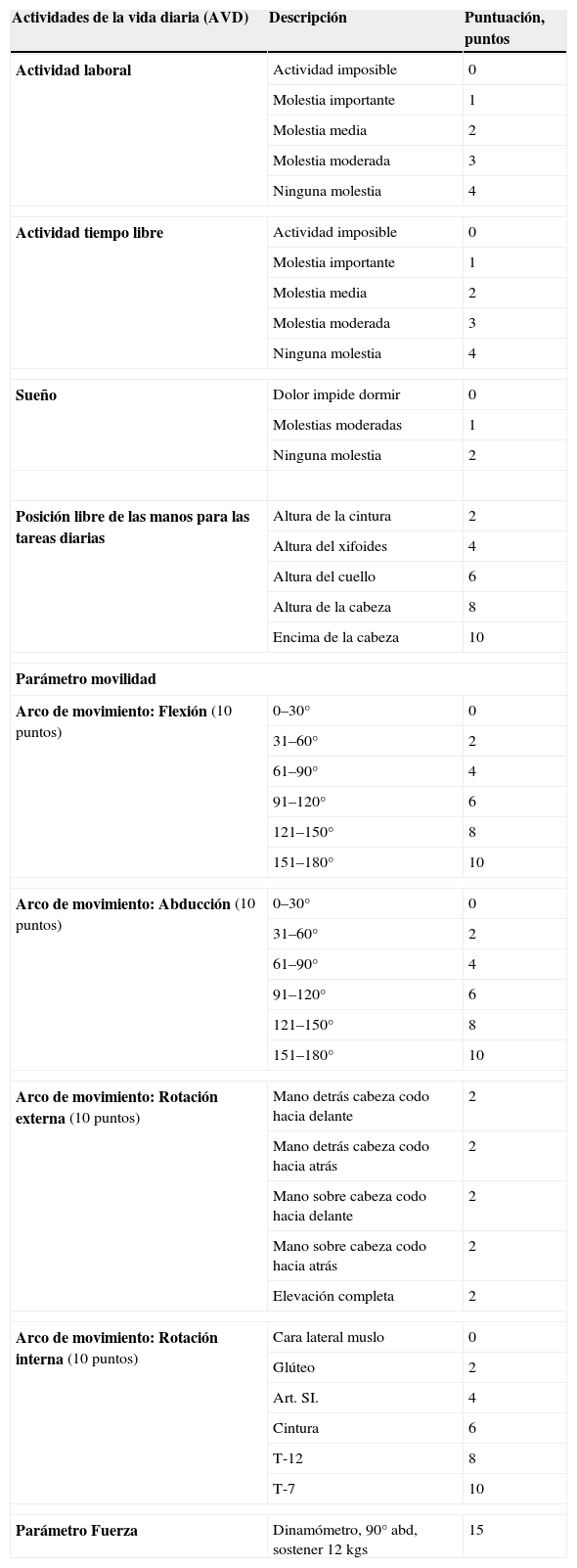La UHF (434MHz) es una modalidad de diatermia profunda que tiene una gran profundidad de acción (6–8cm) con un importante efecto antiinflamatorio y reparador del tejido. El objetivo es analizar la efectividad de la diatermia profunda por UHF en el tratamiento tras movilización bajo anestesia (MBA) de la artrofibrosis glenohumeral.
Material y métodoEstudio prospectivo y aleatorizado durante el periodo de 1 año (marzo 2007–2008) en pacientes diagnosticados de artrofibrosis en la articulación glenohumeral que requirieron MBA y un programa de fisioterapia posterior. Los pacientes fueron asignados aleatoriamente al grupo control o al grupo UHF. Se evaluó el dolor, la movilidad y las actividades de la vida diaria (AVD) mediante el test de Constant-Murley en condiciones basales, 1, 2 y 3 semanas tras la MBA y al alta.
ResultadosSe incluyeron 65 pacientes que fueron aleatorizados (34 grupo UHF, 31 grupo control). Sus características clínicas previas a la MBA fueron similares. Los resultados indican que tanto el protocolo convencional como el que incluye diatermia UHF mejoran de forma estadísticamente significativa (p<0,05) los parámetros de dolor, AVD y rango de movilidad. Cuando el análisis se realiza comparando las mismas variables entre los grupos, el grupo con UHF es superior al convencional al alta, con un mayor porcentaje de recuperación total y con diferencias estadísticamente significativas (p<0,05) en los parámetros de movilidad y AVD.
ConclusionesLa diatermia por UHF mejora los resultados obtenidos con los protocolos convencionales de fisioterapia tras la MBA de la articulación glenohumeral.
UHF (434MHz) is a deep modality of diathermy having great depth of action, that is 6–8cm, with important antiinflammatory and tissue repairing effect. Our study has aimed to analyze the effectiveness of hyperthermia at 434MHz in treating post-manipulation under anesthesia for arthrofibrosis of the glenohumeral capsule.
Material and methodA randomized prospective trial conducted during the period of one year (March 2007–2008) in patients diagnosed with arthrofibrosis in glenohumeral joint requiring manipulation under anesthesia and a subsequent physiotherapy program. The patients were randomly assigned to the control or UHF groups. Outcome measures were the Constant-Murley Test and measurements of pain, mobility and activities of daily living (ADL). Measurements were taken at baseline and 1, 2 and 3 weeks after manipulation under anesthesia.
ResultsSixty-five patients were included, randomizing 34 to the UHF group and 31 to the control group. No significant pre-treatment baseline differences were found between the two treatment groups. The results indicate that both the conventional protocol and that with associated UHF diathermy significantly (p<0.05) improve the pain, ADL and mobility range parameters. When the analysis was made comparing the same variables between the groups, the UHF group was superior to the conventional one on discharge, with higher percentage of total recovery and statistically significant differences (p<0.05) in the mobility and ADL parameters.
ConclusionsWe conclude that diathermy with UHF improves the results obtained with the conventional protocols of physiotherapy after manipulation under anesthesia for fibrosis of the glenohumeral capsule.
Artículo
Si ya tiene sus datos de acceso, clique aquí.
Si olvidó su clave de acceso puede recuperarla clicando aquí y seleccionando la opción "He olvidado mi contraseña".Comprando el artículo el PDF del mismo podrá ser descargado
Precio 19,34 €
Comprar ahora













